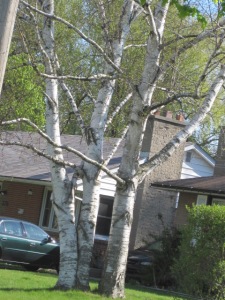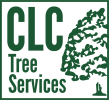First off, I want to thank everyone who stopped by the London Spring Home & Garden Show last weekend. It was great to see so many smiling faces. We look forward to the show every year, and this year was no different. We get to meet new people, say hello to friends and family who visit, plus shake hands with a few former clients that stop by to support our efforts. You are the reason we attend the show every year. Thanks!
It is time to get back to work though. Shaking hands is fine and dandy, but the trees in London, ON are blooming everywhere and we are on the move. Today I thought I would capture images of a few of the trees around the city and see if YOU could identify them. How well do you know your trees? Let’s see…
Trees Around London, ON
This tree is in many yards around the city and is in full bloom at present. What is it? For a hint, here is the Wikipedia description:

“It typically grows to 6–9 m tall with a 8–10 m spread. It generally has a short, often twisted trunk and spreading branches. The bark is dark in color, smooth, later scaly with ridges somewhat apparent, sometimes with maroon patches. The twigs are slender and zigzag, nearly black in color, spotted with lighter lenticels. The winter buds are tiny, rounded and dark red to chestnut in color. The leaves are alternate, simple, heart shaped with an entire margin, 7–12 cm long and wide, thin and papery, and may be slightly hairy below.
The flowers are showy, light to dark magenta pink in color, 1.5 cm long, appearing in clusters from March to May, on bare stems before the leaves, sometimes on the trunk itself. The fruit are flattened, dry, brown, pea-like pods, 5–10 cm long that contain flat, elliptical, brown seeds 6 mm long, maturing in August to October.”
Did that help you? Do you know what the tree is? Hover over the image for the answer and see if you are right.
How about this one? It is green right now, but has a spectacular transformation in the fall.
 About.com Landscaping has this to say;
About.com Landscaping has this to say;
“For most of the year, the cork-like strips that protrude from this plant’s branches are its chief selling point. But all that changes in autumn, when these shrubs put on a fall foliage show for the ages! The fall foliage color ranges from red to pinkish-red. It also bears reddish-orange berries in autumn. Can grow to be over 15 feet tall”
How are you doing with your identifications? Ready for another one? Climb into this beauty.
 TreeHelp.com offers this description;
TreeHelp.com offers this description;
There are few plants that create greater intrigue or visual impact during all four seasons than (this one). In the spring all eyes are enticed with delicate colors offered by emerging leaves and buds. Unopened flower buds may hint of one color and as flowers open, other hues are revealed in a spectacular floral display. As flowers fade the rich foliage offers another subtle contribution to the landscape.
As autumn arrives … foliage and fruit transform to match the vibrant colors of an artist’s palette. Falling leaves reveal the glorious color of the fruit. The snow of winter accents fruit, branches, and tree shape. It is no wonder (they) are called “jewels of the landscape.”
*Blossom colors range from pearly white through delicate pinks to a deep red. There are even cultivars with coral or salmon colored flowers.
Okay, how about one more? These trees have been planted all over London, but as seen in the photograph, sometimes location is an issue and pruning practices by city workers are less than ideal. I wouldn’t be surprised if the city planted one of these trees beside your curb. What is it?
 BorealForest.org has this to say about these trees;
BorealForest.org has this to say about these trees;
Leaves: opposite; 10 – 18 cm long; palmately five-lobed; the shallow lobes and edges with scattered long teeth; 5 or 7 main veins from notched base; dull green with sunken veins above, paler and hairless beneath; turning bright yellow in autumn. Long slender leafstalk, with milky sap at end when broken off. Bark: gray or brown; becoming rough and furrowed into narrow ridges. Twigs: brown, hairless. Flowers: 8 mm wide; with 5 greenish-yellow petals; in upright or spreading clusters; usually male and female on separate trees; in early spring before leaves. Fruit: 4 – 5 cm long; paired keys with long wing and flattened body; spreading widely, light brown, hanging on long stalk; maturing in summer.
So how did you do? Did you score 100% on my little quiz about local trees? Do you have any pictures of your trees bursting into flower or leaf right now? I bet I can name it if you send me a snapshot. Give me a try!
I leave you with one more tree picture to identify, but it is so easy, that I am not even going to give you a description, other than their bark was used by indigenous folks to make canoes and wigwams. And it peels easy. Plus, it was used to make paper. What is it?

Look forward to hearing from you!


[…] Sailor Baborui loves groundcovers.Mayapple with flower budChild care during Teacher Visiting days and ConferencesJune 6th pictureTrees In London […]